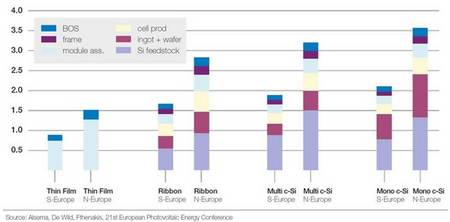Environmental Impact
Environmental Impact
Environmental impact
Climate protection
The most important feature of solar PV systems is that there are no emissions of carbon dioxide - the main gas responsible for global climate change - during their operation. Although indirect emissions of CO2 occur at other stages of the lifecycle, these are significantly lower than the avoided emissions. PV does not involve any other polluting emissions or the type of environmental safety concerns associated with conventional generation technologies. There is no pollution in the form of exhaust fumes or noise.
Decommissioning a system is unproblematic. Although there are no CO2 emissions during operation, a small amount does result from the production stage. PV only emits 21,65 grams CO2/kWh, however, depending on the PV technology. The average emissions for thermal power in Europe, on the other hand, are 900g CO2/kWh. By substituting PV for thermal power, a saving of 835879 g/kWh is achieved.
The benefit to be obtained from carbon dioxide reductions in a country’s energy mix is dependent on which other generation method, or energy use, solar power is replacing. Where off-grid systems replace diesel generators, they will achieve CO2 savings of about 1 kg per kilowatt-hour. Due to their tremendous inefficiency, the replacement of a kerosene lamp will lead to even larger savings, of up to 350 kg per year from a single 40 Wp module, equal to 25kg CO2/kWh. For consumer applications and remote industrial markets, on the other hand, it is very difficult to identify exact CO2 savings per kilowatt-hour.
Recycling of PV modules is possible and raw materials can be reused. As a result, the energy input associated with PV will be further reduced.
If governments adopt a wider use of PV in their national energy generation, solar power can therefore make a substantial contribution towards international commitments to reduce emissions of greenhouse gases and their contribution to climate change.
By 2030, according to the EPIA-Greenpeace Solar Generation Advanced Scenario, solar PV would have reduced annual global CO2 emissions by just over 1,6 billion tonnes. This reduction is equivalent to the output from 450 coal-fired power plants (average size 750 MW).
Cumulative CO2 savings from solar electricity generation between 2005 and 2030 will have reached a level of 9 billion tonnes.
Carbon dioxide is responsible for more than 50% of the man-made greenhouse effect, making it the most important contributor to climate change. It is produced mainly by the burning of fossil fuels. Natural gas is the most environmentally sound of the fossil fuels, because it produces roughly half as much carbon dioxide as coal, and less of other polluting gases. Nuclear power produces very little CO2, but has other major safety, security, proliferation and pollution problems associated with its operation and waste products.
Energy payback
A popular belief still persists that PV systems cannot "pay back" their energy investment within the expected lifetime of a solar generator - about 25 years. This is because the energy expended, especially during the production of solar cells, is seen to outweigh the energy eventually generated.
Data from recent studies shows, however, that present-day systems already have an energy payback time (EPBT) - the time taken for power generation to compensate for the energy used in production - of 1 to 3.5 years, well below their expected lifetime. With increased cell efficiency and a decrease in cell thickness, as well as optimized production procedures, it is anticipated that the EPBT for grid-connected PV will decrease further.
The figure hereafter shows energy payback times for different solar cell technologies (thin film, ribbon, multicrystalline and monocrystalline) at different locations (southern and northern Europe). The energy input into a PV system is made up of a number of elements, including the frame, module assembly, cell production, ingot and wafer production and the silicon feedstock. The energy payback time for thin film systems is already less than a year in southern Europe. PV systems with monocrystalline modules in northern Europe, on the other hand, will pay back their input energy within 3.5 years.




